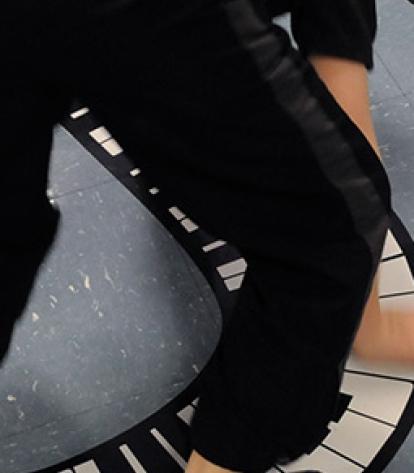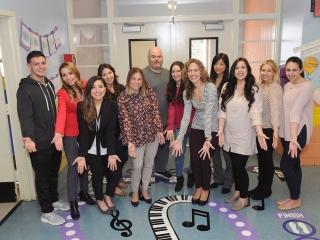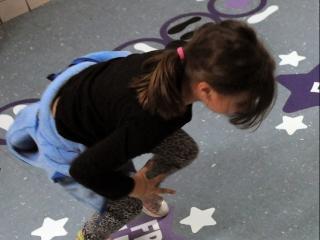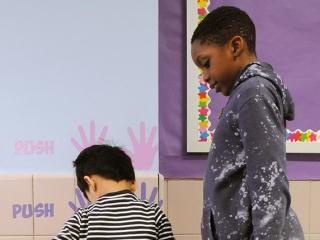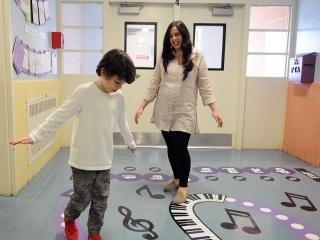Head down and eyes on the floor, the 3rd-grader wouldn’t say why he likes the Sensory Path at PS 9 on Staten Island. Even gentle prompting by a classmate didn’t draw a response.
But as he planted his feet firmly at the start of the pathway and was about to begin hopping and skipping and leapfrogging, his eyes gleamed with confidence. “I got this!” he said.
“We’ve definitely seen an increase in attending and focusing because of the Sensory Path,” said speech therapist Gina-Marie Principe.
The transformation of a section of the first-floor hallway at the Concord school took place in December: Think giant, colorful stickers and prompts placed on the floor and wall to form a winding path.
While appropriate and helpful for all students, the pathway is particularly beneficial to students who may need a break and redirection, for reasons ranging from stress or frustration to sensory processing disorders such as autism. PS 9 offers two programs for children on the autism spectrum: the ASD (Autism Spectrum Disorder) Nest program and the Horizon program.
The types of movements incorporated into the path help get “their bodies ready to focus on the academic,” said Principe.
“Before something really structured in class, or if they have a writing assessment for 45 minutes, or if they need to sit down and read, there’s a difference if they come here to the pathway and then go do their work,” said speech therapist Jessica Arnone.
Likewise, after the sometimes frantic pace of recess, the path also can help settle them down.
“One of my students has a break every day after recess before she goes back upstairs,” said occupational therapist Lai Law. “Running around, she gets disorganized, so this is to regulate or calm herself.”
Created by a special education teacher in Mississippi, the pathway utilizes a series of movements to decrease students’sensory-seeking behaviors while increasing cognition and retention of new information.
PS 9 could have made its own path, with arrows and shapes made of tape, but opted for the more professional version, customized and installed by Holly Clay, the teacher who invented the concept.
“This pathway is unique to our school,” said Arnone. “We formed a committee to work with the physical and occupational therapists to include specific movements the students learn in the building, the school’s vision and mission as an arts school and the school colors.”
Much of the staff has been at PS 9 since it opened in 2013 with only prekindergarten and kindergarten classes. Now, in its first full-enrollment year, PS 9 has 330 students in pre-K through 5th grade. In such a small school, staff members know the students well and wanted to meet their individual needs.
Our team “went above and beyond to make this sensory path possible,” said Chapter Leader Karin Molinelli, who teaches kindergarten in the NEST program. “Everyone in our school does an amazing job to help each student grow academically and socially.”
The collaborative effort even included the custodian. “He also had questions,” Principe said. “How do I clean it? How do I maintain it? He has protocols and regulations to follow as well.”
Because PS 9 integrates the arts into all subjects and activities, the pathway includes musical notes, a keyboard and ballet positions.
The ballet positions initially chosen by Clay were more “classic ballet movements for an adult learning ballet,” said physical therapist Elvira Kacaj. “These are modified to be developmentally appropriate for a child and are positions the children learn in their dance program.”
Professional development in how to use the path was provided for the entire staff. “We had them all try it out,” Arnone said. The PD included information about the benefits of the pathway and situations when it might be helpful.
Every movement on the path has a purpose. Students work on balance and use both sides of their bodies through hopping. They learn motor planning by putting their bodies in certain ballet positions. They build up their strength with weight-bearing activities such as wall pushups, and they gain an awareness of their bodies in space through leapfrogging.
Even parents are excited. “Sometimes I find them at pickup trying to figure out what it is and doing it themselves,” Principe said.
And the students love it: It’s fun, it’s calming, it’s an energy-booster, it makes them feel better, it helps them focus and it’s exercise, they explained.
“When I get frustrated,” said one 2nd-grader, “I usually just stretch my shirt out and chew on it. But I like the Sensory Path because it helps me calm down after I’m really, really frustrated. It makes me get out of my fidgetiness.”
